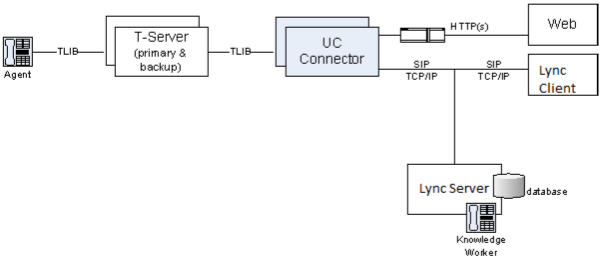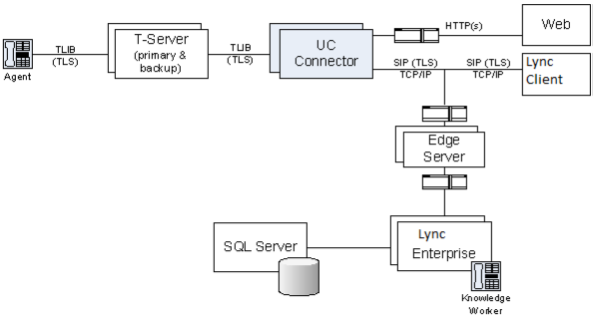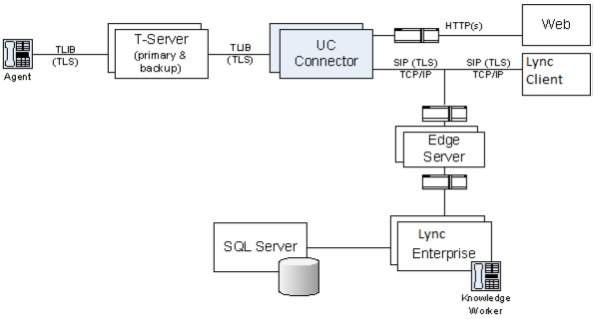Supported Lync / Skype for Business Deployments
Supported deployments with Microsoft Lync / Skype for Business include:
- Deployment with Microsoft Lync Skype for Business Standard Edition
- Deployment with Microsoft Lync Skype for Business Enterprise Edition
- Deployment with Microsoft Lync / Skype for Business Enterprise via Edge Server
Each of the above deployments is summarized below.
Deployment with Microsoft Lync / Skype for Business Standard Edition
The diagram below shows a UC Connector integration with Microsoft Lync or Skype for Business Standard Edition.
Integrations with the Standard Edition of Microsoft Lync / Skype for Business require that the main server components, as well as the database for storing user and conference information, be deployed on a single Front End Server. This integration is used for organizations with less than 5000 users, and which do not require High Availability through clustering for the Lync / Skype for Business Server part of the system. In essence due to the lack of High Availability, Standard Edition is seldom used in real deployments - but mostly in lab settings.
Database
For the Standard Edition, the real-time communications (RTC) database must be kept locally on a Microsoft SQL Server Express instance.
Deployment with Microsoft Lync / Skype for Business Enterprise Edition
The diagram below shows a UC Connector integration with Microsoft Lync / Skype for Business Enterprise Edition, where the Microsoft platform is deployed on multiple servers, the database is deployed on a separate server, and a third-party load balancer is deployed to balance the load across the Front End servers.
With the Enterprise Edition, you can separate the server functions from the database functions as a way to increase capacity and availability. This edition is recommended for organizations that require higher availability through clustering of server roles.
Database
The Enterprise Editions enables you to specify a remote database server. This dedicated Microsoft SQL Server back-end database must be located on a computer that is separate from any of the Enterprise Edition servers.
Deployment with Microsoft Lync / Skype for Business Enterprise via Edge Server
The diagram below shows a UC Connector integration with Microsoft Lync / Skype for Business Enterprise Edition, where the Microsoft platform is deployed on multiple servers, the database is located on a separate server, and a Microsoft Lync / Skype for Business Edge Server is deployed in front of the primary Front End servers.
About the Edge Server
Installed at the perimeter of the enterprise network where the Lync / Skype for Business servers are located, the edge server is used to authorize users from outside of the enterprise firewall before they can access the Lync / Skype for Business deployment.
For more information about deployments that use the Lync / Skype for Business Edge Server, see the Microsoft documentation for the product: https://technet.microsoft.com/en-us/library/mt346417.aspx
Reporting in Microsoft Lync / Skype for Business Integrations
When integrated with Microsoft Lync / Skype for Business, the four standard Microsoft presence states are mapped to user-specific AttributeReason parameters. These KW_UC_STATUS parameters are used to provide Genesys Reporting with additional information about routing requests involving UC Connector users.
The table below shows the mapping between Microsoft presence states and Genesys AttributeReason parameters.
| Communicator Presence | KW_UC_STATUS |
|---|---|
| Busy | RequestAgentNotReady with KW_UC_STATUS of busy. |
| Do Not Disturb | RequestAgentNotReady with KW_UC_STATUS of dnd. |
| Be Right Back | RequestAgentNotReady with KW_UC_STATUS of be-right-back. |
| Away | RequestAgentNotReady with KW_UC_STATUS of away. |
| Available | RequestAgentReady with KW_UC_STATUS of ready. |



